[English] 日本語
 Yorodumi
Yorodumi- PDB-2g44: Human Estrogen Receptor Alpha Ligand-Binding Domain In Complex Wi... -
+ Open data
Open data
- Basic information
Basic information
| Entry | Database: PDB / ID: 2g44 | ||||||
|---|---|---|---|---|---|---|---|
| Title | Human Estrogen Receptor Alpha Ligand-Binding Domain In Complex With OBCP-1M-G and A Glucocorticoid Receptor Interacting Protein 1 NR Box II Peptide | ||||||
 Components Components |
| ||||||
 Keywords Keywords | HORMONE/GROWTH FACTOR RECEPTOR / estrogen receptor / LBD / Grip peptide / HORMONE-GROWTH FACTOR RECEPTOR COMPLEX | ||||||
| Function / homology |  Function and homology information Function and homology informationregulation of epithelial cell apoptotic process / RNA polymerase II intronic transcription regulatory region sequence-specific DNA binding / antral ovarian follicle growth / regulation of branching involved in prostate gland morphogenesis / RUNX1 regulates transcription of genes involved in WNT signaling / RUNX1 regulates estrogen receptor mediated transcription / regulation of toll-like receptor signaling pathway / nuclear estrogen receptor activity / epithelial cell development / steroid hormone receptor signaling pathway ...regulation of epithelial cell apoptotic process / RNA polymerase II intronic transcription regulatory region sequence-specific DNA binding / antral ovarian follicle growth / regulation of branching involved in prostate gland morphogenesis / RUNX1 regulates transcription of genes involved in WNT signaling / RUNX1 regulates estrogen receptor mediated transcription / regulation of toll-like receptor signaling pathway / nuclear estrogen receptor activity / epithelial cell development / steroid hormone receptor signaling pathway / prostate epithelial cord elongation / epithelial cell proliferation involved in mammary gland duct elongation / prostate epithelial cord arborization involved in prostate glandular acinus morphogenesis / locomotor rhythm / mammary gland branching involved in pregnancy / uterus development / negative regulation of smooth muscle cell apoptotic process / aryl hydrocarbon receptor binding / vagina development / TFIIB-class transcription factor binding / cellular response to Thyroglobulin triiodothyronine / androgen metabolic process / regulation of glucose metabolic process / regulation of lipid metabolic process / Synthesis of bile acids and bile salts / mammary gland alveolus development / cellular response to estrogen stimulus / estrogen response element binding / Synthesis of bile acids and bile salts via 27-hydroxycholesterol / Endogenous sterols / Synthesis of bile acids and bile salts via 7alpha-hydroxycholesterol / Mitochondrial unfolded protein response (UPRmt) / nuclear receptor-mediated steroid hormone signaling pathway / : / : / Nuclear signaling by ERBB4 / Recycling of bile acids and salts / transcription regulator inhibitor activity / RNA polymerase II preinitiation complex assembly / cellular response to hormone stimulus / positive regulation of nitric-oxide synthase activity / estrogen receptor signaling pathway / protein localization to chromatin / steroid binding / : / 14-3-3 protein binding / positive regulation of adipose tissue development / Regulation of lipid metabolism by PPARalpha / TFAP2 (AP-2) family regulates transcription of growth factors and their receptors / negative regulation of canonical NF-kappaB signal transduction / peroxisome proliferator activated receptor signaling pathway / regulation of cellular response to insulin stimulus / BMAL1:CLOCK,NPAS2 activates circadian expression / SUMOylation of transcription cofactors / response to progesterone / ESR-mediated signaling / negative regulation of miRNA transcription / Activation of gene expression by SREBF (SREBP) / TBP-class protein binding / nitric-oxide synthase regulator activity / nuclear estrogen receptor binding / nuclear receptor binding / transcription corepressor binding / transcription coregulator binding / negative regulation of smoothened signaling pathway / stem cell differentiation / SUMOylation of intracellular receptors / circadian regulation of gene expression / cellular response to estradiol stimulus / mRNA transcription by RNA polymerase II / Heme signaling / euchromatin / Transcriptional activation of mitochondrial biogenesis / PPARA activates gene expression / Activated PKN1 stimulates transcription of AR (androgen receptor) regulated genes KLK2 and KLK3 / Cytoprotection by HMOX1 / beta-catenin binding / Nuclear Receptor transcription pathway / Transcriptional regulation of white adipocyte differentiation / response to estrogen / RNA polymerase II transcription regulator complex / transcription coactivator binding / male gonad development / nuclear receptor activity / positive regulation of fibroblast proliferation / Constitutive Signaling by Aberrant PI3K in Cancer / sequence-specific double-stranded DNA binding / positive regulation of nitric oxide biosynthetic process / Regulation of RUNX2 expression and activity / Ovarian tumor domain proteases / : / response to estradiol / PIP3 activates AKT signaling / HATs acetylate histones / positive regulation of cytosolic calcium ion concentration / ATPase binding / MLL4 and MLL3 complexes regulate expression of PPARG target genes in adipogenesis and hepatic steatosis / PI5P, PP2A and IER3 Regulate PI3K/AKT Signaling / regulation of inflammatory response / DNA-binding transcription activator activity, RNA polymerase II-specific Similarity search - Function | ||||||
| Biological species |  Homo sapiens (human) Homo sapiens (human) | ||||||
| Method |  X-RAY DIFFRACTION / X-RAY DIFFRACTION /  SYNCHROTRON / SYNCHROTRON /  MOLECULAR REPLACEMENT / Resolution: 2.65 Å MOLECULAR REPLACEMENT / Resolution: 2.65 Å | ||||||
 Authors Authors | Rajan, S.S. / Hsieh, R.W. / Sharma, S.K. / Greene, G.L. | ||||||
 Citation Citation |  Journal: Thesis / Year: 2006 Journal: Thesis / Year: 2006Title: Discovery and characterization of novel estrogen receptor agonist ligands and development of biochips for nuclear receptor drug discovery Authors: Hsieh, R.W. #1:  Journal: J.Biol.Chem. / Year: 2006 Journal: J.Biol.Chem. / Year: 2006Title: Identification of ligands with bicyclic scaffolds provides insights into mechanisms of estrogen receptor subtype selectivity | ||||||
| History |
|
- Structure visualization
Structure visualization
| Structure viewer | Molecule:  Molmil Molmil Jmol/JSmol Jmol/JSmol |
|---|
- Downloads & links
Downloads & links
- Download
Download
| PDBx/mmCIF format |  2g44.cif.gz 2g44.cif.gz | 113.5 KB | Display |  PDBx/mmCIF format PDBx/mmCIF format |
|---|---|---|---|---|
| PDB format |  pdb2g44.ent.gz pdb2g44.ent.gz | 88.3 KB | Display |  PDB format PDB format |
| PDBx/mmJSON format |  2g44.json.gz 2g44.json.gz | Tree view |  PDBx/mmJSON format PDBx/mmJSON format | |
| Others |  Other downloads Other downloads |
-Validation report
| Summary document |  2g44_validation.pdf.gz 2g44_validation.pdf.gz | 1.1 MB | Display |  wwPDB validaton report wwPDB validaton report |
|---|---|---|---|---|
| Full document |  2g44_full_validation.pdf.gz 2g44_full_validation.pdf.gz | 1.1 MB | Display | |
| Data in XML |  2g44_validation.xml.gz 2g44_validation.xml.gz | 22 KB | Display | |
| Data in CIF |  2g44_validation.cif.gz 2g44_validation.cif.gz | 28.6 KB | Display | |
| Arichive directory |  https://data.pdbj.org/pub/pdb/validation_reports/g4/2g44 https://data.pdbj.org/pub/pdb/validation_reports/g4/2g44 ftp://data.pdbj.org/pub/pdb/validation_reports/g4/2g44 ftp://data.pdbj.org/pub/pdb/validation_reports/g4/2g44 | HTTPS FTP |
-Related structure data
| Related structure data |  1zkyS S: Starting model for refinement |
|---|---|
| Similar structure data |
- Links
Links
- Assembly
Assembly
| Deposited unit | 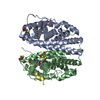
| ||||||||||||||||||||||||||||||||||||||||||||||||||||||||||||||||||||
|---|---|---|---|---|---|---|---|---|---|---|---|---|---|---|---|---|---|---|---|---|---|---|---|---|---|---|---|---|---|---|---|---|---|---|---|---|---|---|---|---|---|---|---|---|---|---|---|---|---|---|---|---|---|---|---|---|---|---|---|---|---|---|---|---|---|---|---|---|---|
| 1 |
| ||||||||||||||||||||||||||||||||||||||||||||||||||||||||||||||||||||
| Unit cell |
| ||||||||||||||||||||||||||||||||||||||||||||||||||||||||||||||||||||
| Noncrystallographic symmetry (NCS) | NCS domain:
NCS domain segments: Component-ID: 1 / Refine code: 4
NCS ensembles :
|
- Components
Components
| #1: Protein | Mass: 29527.887 Da / Num. of mol.: 2 / Fragment: LIGAND BINDING DOMAIN / Mutation: Y537S Source method: isolated from a genetically manipulated source Source: (gene. exp.)  Homo sapiens (human) / Gene: ESR1, ESR, NR3A1 / Plasmid: MCSG7 (PET12-DERIVATIVE) / Species (production host): Escherichia coli / Production host: Homo sapiens (human) / Gene: ESR1, ESR, NR3A1 / Plasmid: MCSG7 (PET12-DERIVATIVE) / Species (production host): Escherichia coli / Production host:  #2: Protein/peptide | Mass: 1579.866 Da / Num. of mol.: 2 / Fragment: GRIP PEPTIDE / Source method: obtained synthetically Details: This sequence occurs naturally in Homo sapiens (humans). References: UniProt: Q15596 #3: Chemical | #4: Water | ChemComp-HOH / | Has protein modification | Y | |
|---|
-Experimental details
-Experiment
| Experiment | Method:  X-RAY DIFFRACTION / Number of used crystals: 1 X-RAY DIFFRACTION / Number of used crystals: 1 |
|---|
- Sample preparation
Sample preparation
| Crystal | Density Matthews: 2 Å3/Da / Density % sol: 38 % |
|---|---|
| Crystal grow | pH: 7 Details: 0.2M AMMONIUM SULFATE 0.1M TRIS PH 7.0 25% PEG 3350, VAPOR DIFFUSION, HANGING DROP, TEMPERATURE 289K |
-Data collection
| Diffraction | Mean temperature: 77 K |
|---|---|
| Diffraction source | Source:  SYNCHROTRON / Site: SYNCHROTRON / Site:  APS APS  / Beamline: 14-BM-C / Wavelength: 0.979 / Wavelength: 0.979 Å / Beamline: 14-BM-C / Wavelength: 0.979 / Wavelength: 0.979 Å |
| Detector | Type: ADSC QUANTUM 315 / Detector: CCD / Date: Dec 17, 2005 / Details: BENT CONICAL SI-MIRROR (RH COATED) |
| Radiation | Monochromator: BENT GE(111) MONOCHROMATOR / Protocol: SINGLE WAVELENGTH / Monochromatic (M) / Laue (L): M / Scattering type: x-ray |
| Radiation wavelength | Wavelength: 0.979 Å / Relative weight: 1 |
| Reflection | Resolution: 2.6→30 Å / Num. all: 14514 / Num. obs: 14166 / % possible obs: 97.6 % / Redundancy: 4.2 % / Rmerge(I) obs: 0.073 / Net I/σ(I): 14.03 |
| Reflection shell | Resolution: 2.6→2.69 Å / Redundancy: 3.3 % / Rmerge(I) obs: 0.314 / Mean I/σ(I) obs: 3.21 / % possible all: 90.1 |
- Processing
Processing
| Software |
| ||||||||||||||||||||||||||||||||||||||||||||||||||||||||||||||||||||||||||||||||||||||||||||||||||||||||||||||||||||||||||||||||||||||||||||||||||||||||||||||||||||||||||
|---|---|---|---|---|---|---|---|---|---|---|---|---|---|---|---|---|---|---|---|---|---|---|---|---|---|---|---|---|---|---|---|---|---|---|---|---|---|---|---|---|---|---|---|---|---|---|---|---|---|---|---|---|---|---|---|---|---|---|---|---|---|---|---|---|---|---|---|---|---|---|---|---|---|---|---|---|---|---|---|---|---|---|---|---|---|---|---|---|---|---|---|---|---|---|---|---|---|---|---|---|---|---|---|---|---|---|---|---|---|---|---|---|---|---|---|---|---|---|---|---|---|---|---|---|---|---|---|---|---|---|---|---|---|---|---|---|---|---|---|---|---|---|---|---|---|---|---|---|---|---|---|---|---|---|---|---|---|---|---|---|---|---|---|---|---|---|---|---|---|---|---|
| Refinement | Method to determine structure:  MOLECULAR REPLACEMENT MOLECULAR REPLACEMENTStarting model: PDB ENTRY 1ZKY Resolution: 2.65→19.7 Å / Cor.coef. Fo:Fc: 0.94 / Cor.coef. Fo:Fc free: 0.917 / SU B: 28.176 / SU ML: 0.273 / TLS residual ADP flag: LIKELY RESIDUAL / Cross valid method: THROUGHOUT / ESU R Free: 0.388 / Stereochemistry target values: MAXIMUM LIKELIHOOD / Details: HYDROGENS HAVE BEEN ADDED IN THE RIDING POSITIONS
| ||||||||||||||||||||||||||||||||||||||||||||||||||||||||||||||||||||||||||||||||||||||||||||||||||||||||||||||||||||||||||||||||||||||||||||||||||||||||||||||||||||||||||
| Solvent computation | Ion probe radii: 0.8 Å / Shrinkage radii: 0.8 Å / VDW probe radii: 1.2 Å / Solvent model: MASK | ||||||||||||||||||||||||||||||||||||||||||||||||||||||||||||||||||||||||||||||||||||||||||||||||||||||||||||||||||||||||||||||||||||||||||||||||||||||||||||||||||||||||||
| Displacement parameters | Biso mean: 59.705 Å2
| ||||||||||||||||||||||||||||||||||||||||||||||||||||||||||||||||||||||||||||||||||||||||||||||||||||||||||||||||||||||||||||||||||||||||||||||||||||||||||||||||||||||||||
| Refinement step | Cycle: LAST / Resolution: 2.65→19.7 Å
| ||||||||||||||||||||||||||||||||||||||||||||||||||||||||||||||||||||||||||||||||||||||||||||||||||||||||||||||||||||||||||||||||||||||||||||||||||||||||||||||||||||||||||
| Refine LS restraints |
| ||||||||||||||||||||||||||||||||||||||||||||||||||||||||||||||||||||||||||||||||||||||||||||||||||||||||||||||||||||||||||||||||||||||||||||||||||||||||||||||||||||||||||
| Refine LS restraints NCS | Dom-ID: 1 / Refine-ID: X-RAY DIFFRACTION
| ||||||||||||||||||||||||||||||||||||||||||||||||||||||||||||||||||||||||||||||||||||||||||||||||||||||||||||||||||||||||||||||||||||||||||||||||||||||||||||||||||||||||||
| LS refinement shell | Resolution: 2.65→2.718 Å / Total num. of bins used: 20
| ||||||||||||||||||||||||||||||||||||||||||||||||||||||||||||||||||||||||||||||||||||||||||||||||||||||||||||||||||||||||||||||||||||||||||||||||||||||||||||||||||||||||||
| Refinement TLS params. | Method: refined / Refine-ID: X-RAY DIFFRACTION
| ||||||||||||||||||||||||||||||||||||||||||||||||||||||||||||||||||||||||||||||||||||||||||||||||||||||||||||||||||||||||||||||||||||||||||||||||||||||||||||||||||||||||||
| Refinement TLS group |
|
 Movie
Movie Controller
Controller



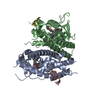
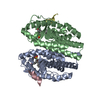
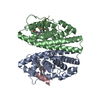

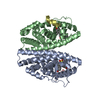

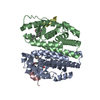




 PDBj
PDBj

















